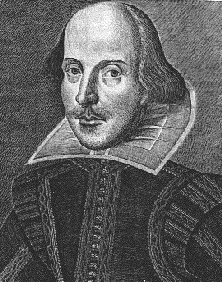
The traditionally identified Shakespeare:
Will Shakspere (1564-1616).
Michael Delahoyde
Washington State University

The traditionally identified Shakespeare:
Will Shakspere (1564-1616).
A recent issue of The Shakespeare Oxford Newsletter [42.2 (Spring 2006): 21] brings this quotation from a Wesleyan professor to our attention:
These are all the facts we know beyond question; you can put them all into one sentence. He married at eighteen a wife who was twenty-five or twenty-six; at about twenty-one he went up to London; in the course of the next twenty years achieved immortality and a rent-roll; at thirty-four bought a house and corner lot in his native village; at about forty-five settled there to reside; at fifty-two died. That is the whole story. (C.T. Winchester, An Old Castle and Other Essays. NY: Macmillan Co., 1922.)It's not simply that we don't know much of this person's life, but we don't get any records of what we would like to know. The separation between life records and the works is extreme -- even more pronounced than Chaucer's two hundred years earlier, where we can at least match likely poetic presentations with court records of royal gifts, literary influences with foreign travel, etc.
William Shakspere was the eldest son and third child of eight born to John and Mary, baptized 26 April 1564 and so born maybe 23 April. His father was a glover, wool-dealer, money-lender, alderman, and bailiff (mayor). Later on, the family fortune declined (some try to suggest because of Catholic sympathies).
William probably attended free grammar school, the King's New School of Stratford-on-Avon (c. 1571-1577) until his father fell into financial straits. However, no records of his schooling exist. There is one shaky report from an actor in a later troupe who claims a Shakespeare taught Latin as a schoolmaster for a while, but the rumor is not much credited.
A marriage bond was issued, guess why, to William Shakspere and Anne Hathwey of Stratford 28 November 1582: he was 18; she was 26. A daughter, Susanna, was baptized 6 months later on 26 May 1583. Twins, Hamnet and Judith (named after a pair of neighbors), were baptized 2 February 1585. William seems to have left that home for London soon after.
We have no records, but some speculate that he arrived in London in the late 1580s. One account says he found work minding the horses of theatergoers.
In 1592 a work ascribed falsely and dishonestly to university-educated playwright Robert Greene refers to a "Shake-scene" and seems to be indicating that someone is "an upstart crow, beautified with our feathers." This has been taken as an indication that Shakespeare was inspiring jealousy for his successful plagiarisms. But all aspects of this reference are ambiguous.
In 1593 appears the Ovidian work Venus and Adonis, and in 1594 The Rape of Lucrece -- both dedicated to Earl of Southampton, often taken to have been a patron. The former is declared in the dedication "the first heir of my invention" -- not "my first invention." This can be taken as a reference to the "invention" of a pseudonym: the first piece published under an adopted name. A closing of the theaters is usually said to have been responsible for this type of work from the author and for the bulk of the Sonnets too.
Records make Shakspere a member of the Lord Chamberlain's Company of Players 1594-1595 -- we have a record of payment for Christmas performances. Shakspere is listed as a shareholder. This group built and occupied the best-known Elizabethan theatre, the Globe, and later became the King's Men for James I.
Son Hamnet died and was buried on 11 August 1596. We have minor legal records and land purchases from this period. Shakspere owns New Place, a classy Stratford home, in 1597. He is listed as an important holder of corn and malt in Stratford 1598. He has lots of money but other records make it look as if he acted in a Jonson play in 1598 and 1603.
Twelve plays of Shakespeare are listed in a 1598 manual of English literature from Chaucer to contemporary times.
Shakspere seems to have been part owner of the Globe theater in 1599. A granddaughter, Elizabeth, was born to Susanna in 1608. We have more legal documents and land purchases in Stratford.
Shakspere oddly "retired" to Stratford some time in the first decade of the 1600s, visiting London occasionally perhaps, but living in Stratford until his death. In January 1616 he drew up his will, then in March changed it to provide his daughter Judith greater protection in light of her troubled marrriage. Shakspere died 23 April 1616 and left his "second best bed" to his wife Anne. This is the pedestrian will of a businessman, with no mention of literary remains. There was no notice of his death as if he was of any importance, despite the fame of the plays. There was no gravestone. We only have an identified grave because his wife and daughter were later buried beside the unnamed stone. A sketch of a monument many years later shows him to be nothing more than a grain dealer. The family line died out.
As for the plays, some had been printed in quarto editions without the author's editorial supervision, from manuscripts, or prompt books, or pirated texts reconstructed from the memory of actors or spectators. In 1623, the First Folio was published -- 36 plays, half of which had not appeared in print before -- with the famous preliminary document by Ben Jonson: "He was not of an age but for all time." The title page puts forth an image of Shakspere. But....